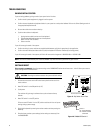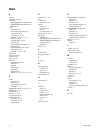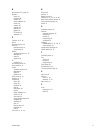74 C1522M-C (2/05)
Matrix switcher This is also known as a cross-point switcher. The cross-points are actually electronic switches that
select any video input onto any video output at any one time, preserving the video impedance
matching. One video signal can simultaneously be selected on more than one output. More than one
video input can be selected on one output, in a sequential switching between inputs (unless the input
is routed through a multiplexer, which allows more than one input to be viewed on the output monitor
at any one time).
Momentary operation The auxiliary output operation is activated briefly and then turns off.
Multiplexer (MUX) A multiplexer allows an operator to view more than one video signal (usually either four, nine or
sixteen signals) at one time on a single monitor. A multiplexer can also send these multiple images to
the video recorder, switching rapidly between image from each camera.
NTSC The American color TV standard, used in North America, Japan, and a few other countries. It specifies
525 lines/screen, and 29-30 frames/sec.
Null modem cable A null modem cable allows you to connect your PC to another nearby PC or serial device by “crossing
over” (reversing) their respective pin contacts. (A null modem cable is limited to 30 feet in length.)
PAL The color TV standard (50Hz) used by European, Asian, and some Latin American countries. It specifies
768 pixels/line, 576 lines/screen and 25 frames/sec.
Parity type The parity bit is used to identify whether the bits being moved arrived successfully. Parity bit checking
can be based on odd or even bits. No parity means that a parity bit is not transmitted or checked.
Pattern A pattern is a user-defined, viewable camera path with a definite beginning and end. The pattern can
consist of any standard pan and tilt or lens command. Once defined, the pattern is easily activated by
a system operator or through an automated event. The pattern will run continuously until it is
deactivated. The number and time length of patterns varies with different positioning systems.
Physical input A number representing an actual BNC camera input on the rear panel of the matrix switcher. This
number cannot be changed.
Preset A preset allows operators to direct a PTZ (camera positioning system) to move to a predetermined
scene on keyboard command or as a result of an alarm. In addition to moving the camera, a
descriptive title can appear on the screen. The type of camera positioning system determines the
number of presets available.
Priority control This is the level of priority a system keyboard has to control a PTZ camera positioning system and to
access CM6800 Matrix Switcher on-screen programming menus.
PTZ This is a camera positioning system with pan, tilt, and zoom capabilities.
Random scan This is a camera scan moving in a random pattern.
RJ-45 wall block This is a wall block with eight terminals for connecting RS-232, RS-422, and RS-485 communication
lines. (This is Pelco part number CON12J00820360Z.)
RS-232 This is an Electronics Industry Association (EIA) interface standard used for data communication; the
normal connection distance is 50 feet (15 m). Pelco uses this standard for communication from a
controller to a PC or RS-232 network. The Pelco three-wire connection provides one wire for transmit,
one wire for receive, and one wire for common.


















